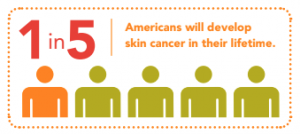Skin cancer is the most common form of cancer in the United States. It is estimated that one in five Americans will develop skin cancer in their lifetime with approximately 9,500 people diagnosed every day.
What causes skin cancer?
The greatest risk factor for development of skin cancer is exposure to UV light, of which there are two types; UVA and UVB. UVA rays, which can pass through glass, leads to premature aging of the skin. More importantly, UVA suppress the immune system, interfering with its ability to protect you against development and spread of cancer. UVB rays, which are blocked by glass, are known as the burning ray responsible for sunburns. Excessive exposure to both forms of rays can lead to skin cancer.
Three main types of skin cancer:
- Basal cell carcinoma (BCC): This is the most common form of cancer worldwide. These cancers often appear on the sun-exposed areas of the face, scalp, ears, back and extremities. The most common appearance is that of a small domed-shaped lesion that is pearly white and or bleeds and heals only to recur again. Individuals with one BCC are at a 40% risk of getting a second one within 5 years.
- Squamous cell carcinoma (SCC): As the second most common type of skin cancer, over 700,000 cases of SCC are diagnosed annually. They are typically found on the same sun-exposed areas as seen with BCC but can occur on any part of the body. The appearance is one of a crusted or scaly patch with a red, inflamed base, a growing lesion, or a non-healing ulcer. If left untreated SCC can destroy much of the tissue surrounding the lesion. As with BCC, this type of skin cancer is easily treated if detected early.
- Melanoma: This is the most serious form of skin cancer. It can present on any part of the body, with the highest risk still being sun-exposed areas and is characterized by uncontrolled growth of pigment-producing cells. It is estimated that 178,560 new cases of melanoma will be diagnosed in the U.S. in 2018. Before age 50 incidence rates are higher in women, but by age 65, rates are twice as high in men. It is not just a diagnosis for older individuals, as it is now the most common form of cancer for young adults ages 25-29. The good news is that if detected and treated before it spreads to the lymph nodes, melanoma has a 98% five-year survival rate.
What are skin cancer risk factors?
- Exposure to natural and artificial ultraviolet light.
- People with skin that burns easily. Even one blistering sunburn during childhood can almost double a person’s chance of developing melanoma. Studies show that experiencing five or more blistering sunburns between the ages of 15 and 20 can increase melanoma risk by 80% and other skin cancer types by 68%. Even increasing intermittent sun exposure during one’s lifetime is associated with an increased risk of skin cancer.
- Individuals with fair skin and or blond or red hair.
- Use of tanning beds, especially in younger women. Up to 400,000 cases of skin cancer each year in the U.S. are attributable to tanning bed use.
- People with more than 50 moles, atypical moles or large moles are at higher risk.
- Caucasians and men over 50 years of age.
- A family history of melanoma.
Prevention and Detection
Since exposure to UV light is the greatest risk factor, protecting your skin from the harmful UV rays is the best way to prevent skin cancer.
The following tips will help protect against the suns damaging rays:
- Use sun screen with a Sun Protection Factor of 30 or greater.
- Wear protective clothing. Wide brimmed hats are recommended as are sunglasses that block UV rays. Cover the arms and legs. Dark tightly woven clothing absorbs and blocks UV rays better than light, loose fitting cloths. Admittedly, the dark, tightly woven clothing may not be the best choice in the hot Central Texas weather; the looser fitting clothes will still provide protection and be more comfortable.
- Stay in the shade from 10 am to 4pm.
- Avoid tanning beds and sun lamps.
- Perform self-skin checks. Research shows that if you involve a partner in this process there is an increase in early detection of skin cancer.
- Look for warning signs such as a spot that changes in shape, size or color or one that does not heal, bleeds or itches.
Early detection is key when it comes to skin cancer. If you have concerns about a suspicious mole or lesion, make an appointment with my office or your Dermatologist to have it checked out. Many issues can be diagnosed and treated right here in the office.
Download the Skin Cancer Treatable Beatable Flyer >>
The information provided in this newsletter is based on statistics compiled by and recommendations from the American Academy of Dermatology.





